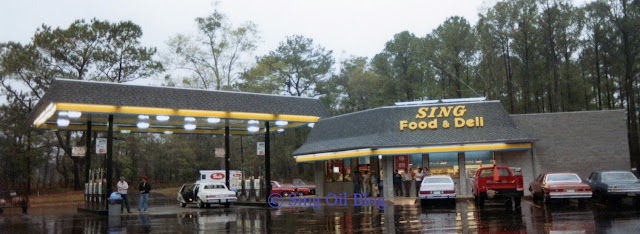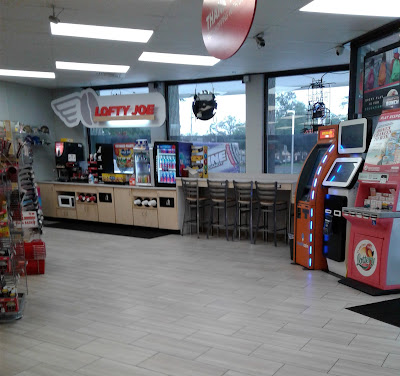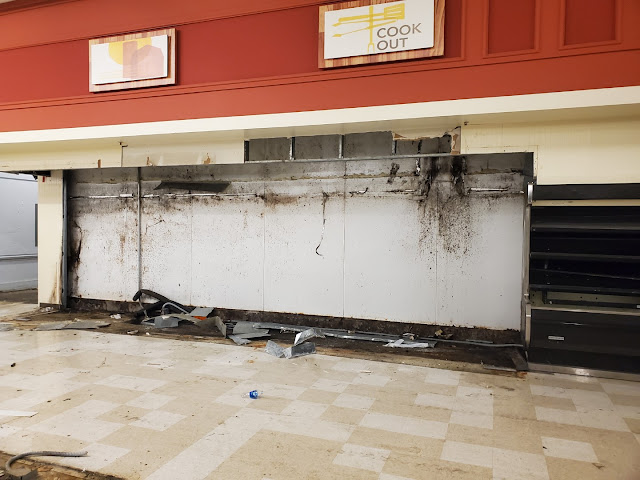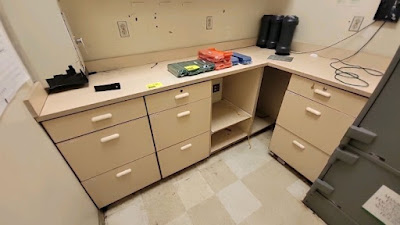Jacksonville #3 - Jacksonville, FL
Hello, and Merry Christmas everyone! So while our usual host of the Sing Oil Blog, The Sing Oil Blogger himself, is busy wrapping presents, drinking eggnog, and gleefully awaiting the arrival of Santa Claus to bring him a new piece of retail memorabilia tonight, I have volunteered to step in on his behalf and present you with today's Sing Oil Saturday post. For those of you who don't know me, I am The Albertsons Florida Blogger, owner and proprietor of my namesake blog that profiles the former Albertsons stores around Florida (along with some other interesting supermarket finds in between). While the Sing Oil Blogger was busy photographing some former Albertsons stores in Pensacola for me (the first of which we toured last week), I was out and about in Jacksonville to bring you some coverage of that city's former Sing locations. Much like how Pensacola is outside of my usual travel realm (Central Time - I've always wondered what that's like!), the exotic lands of Northeastern Florida and Jacksonville are a bit of a stretch for the Sing Oil Blogger to get to easily. In order to bring you all some coverage of these far-flung lands from our respective coverage areas, the two of us are trading blogs this time around to bring you some interesting new coverage (and to keep our readers on their toes!). So now that we've already seen Alex Trebek host Wheel of Fortune, the time has come to see what it's like watching Pat Sajak host Jeopardy! as I take my crack at bringing you this week's latest installment to the Sing Oil Blog - so let's begin!
Prior to me discovering this blog a little over a year ago now, I had never heard of the Sing Oil Company of Thomasville, GA. With Sing Oil's primary concentration being in Western Georgia and the greater Tallahassee, FL area, it makes sense that I'd never heard of the company, as I grew up in the Floridian Peninsula, a place that Sing Oil had hardly ventured into. Based on some research conducted by our usual host of this blog, Sing Oil appeared to be buying property in the Floridian Peninsula in the mid-late 1980's, including two confirmed purchases of property in Citrus County and St. Johns County. With Sing Oil's purchase of these lots, it seems likely that a Peninsular expansion of some kind was in the works, however, any progress on those plans was lost to time when the Sing Oil Company was sold to Amoco in 1990. While we may never know what Sing Oil's plans for the Floridian Peninsula may have entailed, Sing did get close to the Peninsula with one of their expansion efforts. In the early 1970's, Sing Oil began opening stations in Jacksonville, a city that serves as the gateway to the rest of the Peninsula below it. Jacksonville would end up gaining 4 operational Sing Oil stations over time, with today's location, the company's third in the city, opening in 1984.
Back in 1984, there really wasn't a whole lot to be seen in this part of town. Besides the nearby interchange between Old St. Augustine Road and Interstate 295 (aka the "West Beltway" by locals), it was just forested land all around - you had to go about a mile to the north of here on Old St. Augustine to find any shreds of major development back then. While its location near the highway interchange presented itself as being ideal for a gas station in that respect, Sing Oil actually had grander plans that attracted them to this location. Sing Oil purchased not only the land for the construction of the gas station, but also a larger tract of land just behind it to develop into new neighborhoods. The mid-1980's were the perfect time to begin a housing project in this area, with development from the north inevitably encroaching southward as Jacksonville's population continued to grow. That, in addition to its prime location near the highway interchange, made this area quite the attractive opportunity for development, and Sing saw that. According to the Sing Oil Blogger, Sing Oil involved themselves in a number of side projects through the years, so this housing development wasn't a complete one-off. In the past we've seen some of Sing's other side projects, like The Happy Penny Grocery Store and a foray into laundry services, but I believe this is the first we've discussed of Sing's housing development ventures.
Editor's note from The Sing Oil Blogger: this post inspired me to dig back into the Duval County records, where I discovered Sing also had a hand in the development of The Junction and Losco Junction subdivisions. I wouldn't be surprised if there were others in the area as well. Sing purchased the land for The Junction, along with the lot that this station is situated on, on April 8, 1983, as recorded on page 1021 of volume 7386 in the Duval County Property Records.
Construction on the new housing development, named Bentley Woods, began shortly after the new convenience store and gas station opened, with the Sing Oil Blogger having record of a "Financing statement related to the development loan for joint venture with D.W. Hutson Construction, Inc." dated January 1986 per some old company records. It should be noted these records of his could be related to another one of Sing's housing developments in the Jacksonville area (Azalea Point) - however, both developments began construction around the same time. Interestingly enough, if you clicked on that previous link and scanned over the Bentley Woods development, there actually lies a blatantly obvious clue as to what company was behind the development of that neighborhood (don't read on to the next paragraph if you want to look at the map and take a guess first, but if you know your Sing Oil history, what I'm talking about should jump right out at you).
Now that you've seen the map, did you see it? In the middle of the neighborhood is a short street called Singletary Road - which is a reference to the founder of the Sing Oil Company, L.H. Singletary (either that or a reference to the company's president at the time, L.H.'s son Richard Singletary). Regardless of which individual the street was named after, Singletary Road was left behind as a subtle nod to the people who developed that community.
Back to the station itself, Jacksonville #3 remained with the Sing Oil Company until it was sold to Amoco in 1990. Amoco retained ownership of this station through the company's merger with BP in 1998, however, a few years after that in 2002, this location was sold to Giant Oil. Giant Oil is a large franchisor of gas stations throughout Florida, who sells the stations to individual owners to operate while acting as the wholesaler and supplier for the fuel and the convenience stores. It's easy to spot a station owned by Giant Oil as all their stations use the "On The Fly" convenience store banner. While the convenience stores all use the same branding, Giant Oil uses a number of fuel brands for their stations, including BP, Amoco, Marathon, Exxon, Mobil, and Chevron. This station happens to use the BP branding for its fuel, so Amoco didn't lose out too much when they sold this station, as they continue to sell fuel here through the BP branding. Interestingly, as I was informed by the Sing Oil Blogger, Jacksonville #3 and Jacksonville #4 are the only two former Sing stations sold to Amoco in 1990 that followed the intended corporate lineage of the parent companies - Sing to Amoco to BP - and retain that branding today.
Jacksonville #3 is actually a very well preserved example of Sing's 1980's "Large Format Square" design - well, at least the convenience store is anyway. The photo above, taken at Sing's Bradfordville, FL location, shows what Jacksonville #3 would have looked like when it was first built. Jacksonville #3 and Bradfordville were essentially twins, so I've included a few of the Sing Oil Blogger's classic photos from the Bradfordville post for comparison in this one (although the Bradfordville post contains many more historical images too, so a quick scan through that may help you understand Jacksonville #3 much better). Comparing the above photo to the photos I've shared of Jacksonville #3 already, you'll notice 2 major differences. The most obvious change is that the gas pump canopy at Jacksonville #3 was rebuilt. That happened around the turn of the 2010's, where the small, original two island design was torn down to make way for a larger, more modern 5 island setup (leading to 10 total fueling stations in the present, compared to the 4 there would have been originally). The other change was a bit more recent, as around 2020, the original roof above the doors and windows was replaced with a flatter design, as opposed to the original two-tiered roof design.
Even with the new roof and the new fuel canopy, it's still quite obvious the lineage of this convenience store. According to the Sing Oil Blogger about this location in particular: "Jacksonville #3 appears to have been a mid-range performing store for the company, but it still only did half as well as the best-performing Tallahassee #7, which was leaps and bounds ahead of the runner-up in Macon and the third-seat of Tallahassee #10."
The ribbed concrete block used on the exterior of this building is an original Sing feature. While many people associate that ribbed concrete look with Kmart (who loved using that same style of block on their stores in the late 1970's and early 1980's), that block actually reminded me of a convenience store we used to frequent a lot when I was younger (which was not a Sing, of course, and nowhere near here), as it was built with that same block! Ribbed concrete block must have been a popular look in the 1980's.
This convenience store has its entrance located at the corner of the building, a corner which used to look directly out at the fuel pumps. To the left of the door is the cashier counter (which is still in that place today), however, in this photo, you can see another remnant from the Sing Oil days - the former exterior cashier window. This design made for a more convenient place to pay for your fuel without having to go inside and wait in line. It's an interesting concept, but one that apparently didn't catch on, as I can't think of any other convenience store that uses such a concept these days (except for those little windows at the Walmart/Sam's Club gas stations kiosks - although I wouldn't call those kiosks a convenience store by any means!). That window has probably been sealed over since the time when Amoco took control, however it was never totally removed.
Anyway, now that we've made it this far, let's head inside and see what it's like in there:
Entering the convenience store and turning to the right, we find the coffee nook, aka "Lofty Joe". However, lofty is about the last word I would choose to describe this store's coffee nook, as the coffee selection was pretty limited (a kettle each of regular and decaf, and a machine that dispensed 3 flavors of iced coffee). It's a pretty sad selection compared to what us spoiled Floridians can find at a modern Wawa, however, I guess this place makes up for the limited coffee selection by offering a vat of boiled peanuts alongside the coffee display (I know for certain Wawa doesn't sell those!). Coffee with boiled peanuts, a new southern delight! (The Sing Oil Blog seems to be presenting a lot of challengers to the classic Southern lumpy Coke of late!)
Back when Sing Oil was here, the right side of the store where the coffee bar is now would have looked more like what we see in the image of the Bradfordville store above. While the interior is still of the same basic design, Sing Oil used the right side of the convenience store to house the "general merchandise" section, if you will. One of the things that made Sing's stores unique was many of them carried general merchandise staples alongside the usual beer, snacks, and smokes convenience stores are famous for. As you can see, Sing carried a large automotive selection, along with gardening supplies, hardware, and household goods. With Sing having a tendency to place stores "off the beaten path", favoring opening locations in more residential parts of town further away from big box stores, this one-stop format was quite successful. Sing's sales of these types of products even lead to the company's brief foray into opening a full-blown hardware store at one of the company's Tallahassee locations.
Here's a closer look at the coffee counter, complete with a hat rack right next door so you can look cool as you sip your coffee (with or without peanuts!).
While this store is still mostly original to Sing Oil in terms of design and feel, later modifications made by Giant Oil and On The Fly have changed some things around. Since coffee wasn't originally over here, this counter is obviously not original to Sing. The flooring has also been redone since Sing was here, with Sing using those small brick paver-like tiles as seen in the throwback photo from the Bradfordville store. I wouldn't be surprised if those original tiles from Sing are still present under the modern wood-like ceramic tiles.
Sing's general merchandise selection has been eliminated by On The Fly, who now stocks the store like any other convenience store out there these days, with shelves of candy and soda over here instead of hammers and watering cans. However, behind this aisle is something that remains today that would have been the same as in the Sing Oil days - the drink coolers in the back of the building.
I don't quite remember what I was going for with this photo, but here you see some more of the store's interior aisles, in addition to the soda fountain and fried chicken counter in the background.
Here's a look down the store's center aisle, looking back toward the front door.
Some random beanie babies for sale here, to give you company as you sip your coffee and eat your boiled peanuts (and to stare at your new hat).
The cashier counter is located just out of frame to my left here, with Flyby Kitchen's famous fried chicken counter in the foreground. Flyby Kitchen is On The Fly's house brand for prepared food options, housed in what would have been Sing's Delicatessen, which we can see at the Bradfordville store in the image below:
Fried chicken is quite different from the sandwiches Sing used to serve here, but it's nice that On The Fly did manage to keep the food service counter operating as one (even if in the name of modernization, all the funky red fixtures were removed). The photo above also shows the original placement of the "Drink Center", home to the coffee and soda machines. While the coffee station was moved to the other side of the store, the soda fountain remains over here, however now placed against the wall where the "Frozen Food" coolers used to be.
Back outside the store, here's a look toward the gas pump canopy again. It's not the original canopy as I mentioned earlier, but for the sake of completeness, let's take a quick look at that:
All traces of the original canopy are gone, as the new canopy stretches through most of the area where the original one once stood.
While Giant Oil has affiliations with a number of oil brands, BP seemed to be the most common affiliation for their stations in the Jacksonville area. Former Sing station Jacksonville #4 (which we'll see on the blog at a later time) is also now a Giant Oil BP/On The Fly franchise, although that station has a totally different feel than the one we just saw today.
Also, (and what most of you are probably thinking now after seeing the above photo) what the heck happened to that fuel pump?!
At the time of my visit, pump 9 and 10 was looking like something had backed into it, with the crippled fuel pump cordoned off with all that caution tape. I feel pretty certain this pump will be out of commission for a little while, as that looks like a project to fix...
Out by the road, we find the station's road sign (which is not leftover from Sing, but standard issue by BP). However, if we're looking for Sing Oil remnants, we can find some of those just over to the right of the road sign:
While the machinery itself has probably been updated, that light fixture over the air and vacuum station is our classic Sing Oil issued light. We've seen a number of these lights on the blog in the past, one of our many tell-tale signs of a former Sing.
That photo of the air and vacuum station wraps up my ground coverage of former Jacksonville #3. We'll conclude my post with the usual historic imagery, starting with a few keynote scenes from Google Streetview:
…and that Winn-Dixie is where we'll be headed next for the "More Than Convenience" segment of this post. Today's MTC will be located over on My Florida Retail, where we'll take a quick tour around Winn-Dixie #179. Be sure to head over there for the rest of today's coverage, as we check out a Winn-Dixie in their hometown.
Editor's note from The Sing Oil Blogger: Neither AFB nor I realized it at the time, but the land where this Winn-Dixie now stands was once owned by Sing Oil Company! It wasn't easy to decipher, but I managed to dig up the April 8, 1983 warranty deed (buried in different digitized paperwork from 1992) for this station's parcel. After struggling through the surveyor notes, I was able to trace out a rough sketch of the 1983 property lines, which include the modern-day convenience store, Winn-Dixie shopping center, and The Junction housing development. I thought this was a cool find, and it certainly adds a while new meaning to today's More Than Convenience post! Now, I'd just love to find out if Sing had any part in the Winn-Dixie's development . . .
 |
| Courtesy Charles Burgess, Jr (Flickr) - August 12, 2011 - Winn-Dixie #179 |
That Winn-Dixie originally opened with the "inverted check" façade, but was modified to what we see today during the store's Post-Bankruptcy remodel between 2007 and 2011. The store's entrance was moved from the left side of the store to the alcove on the right we see today, and the overall design was squared off from it's previously angular nature. I also think the "Food" and "Pharmacy" lettering we see above date's back to this store's Marketplace days. Make sure to check out AFB's post because this store certainly has its share of oddities!
I hope everyone enjoyed today's post, and that I didn't do too bad of a job profiling this former Sing Oil station. If he lets me back on, I may have some other Jacksonville-related material to share with you on the Sing Oil Blog again in the future. However, until that time comes, I'll hand things back over to the Sing Oil Blogger once he recovers from his Christmas cookie sugar coma!
Anyway, I'm glad to have contributed this piece of Sing Oil history to the blog, and until the next time,
The Albertsons Florida Blogger














































































































































